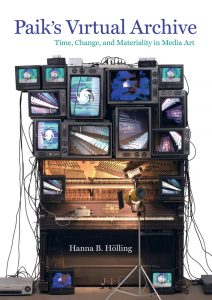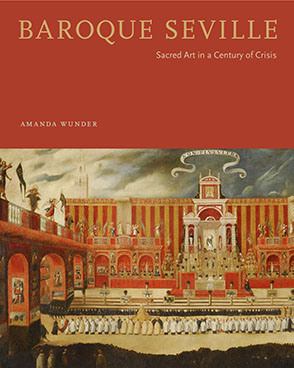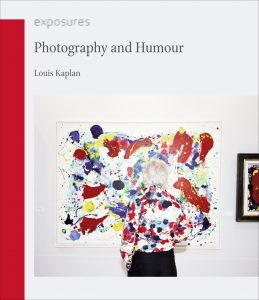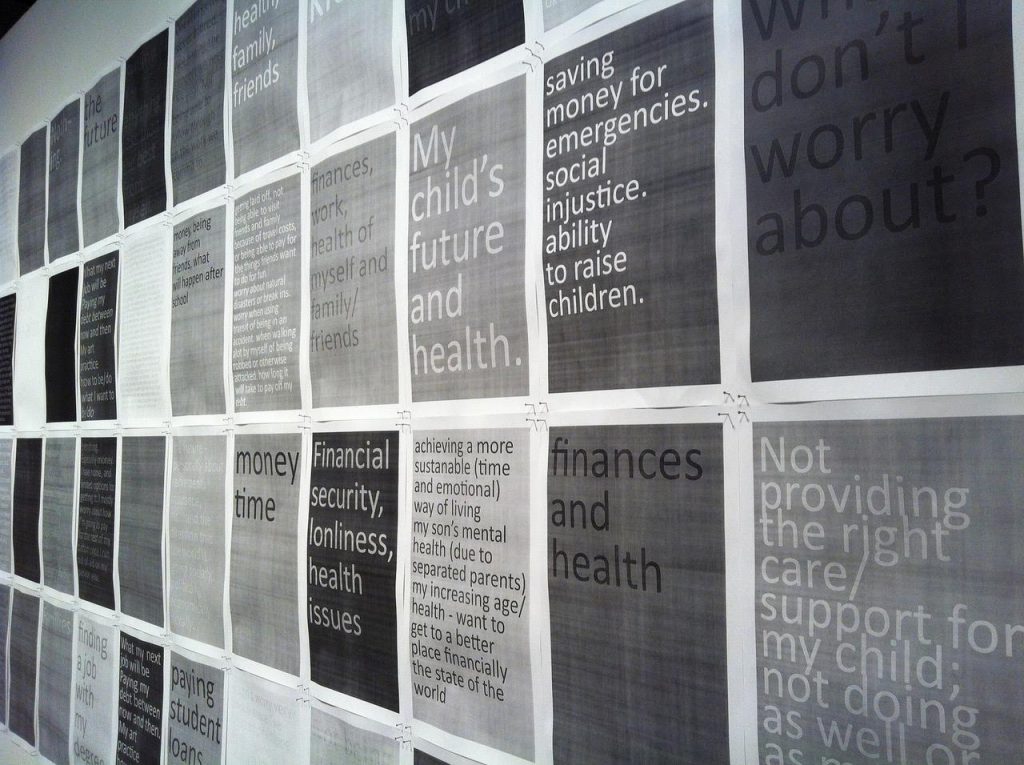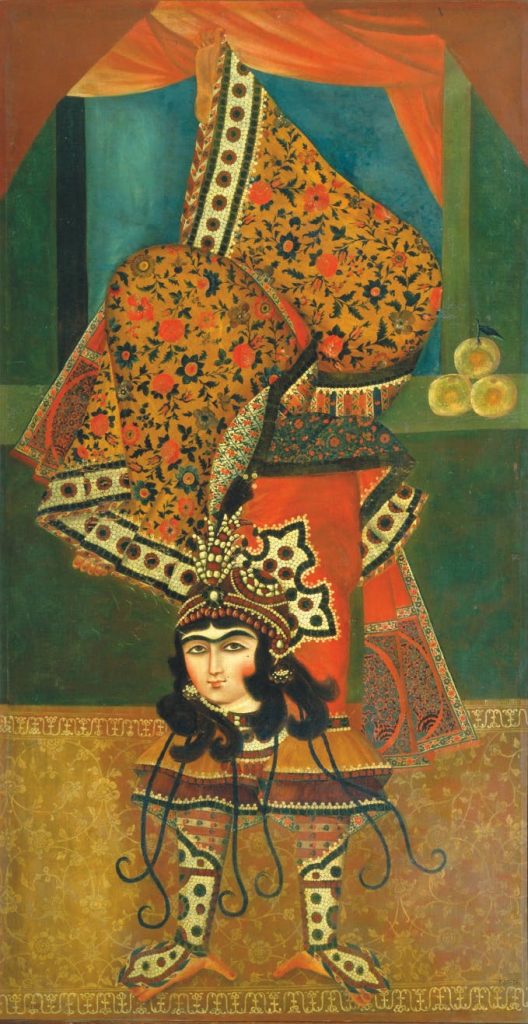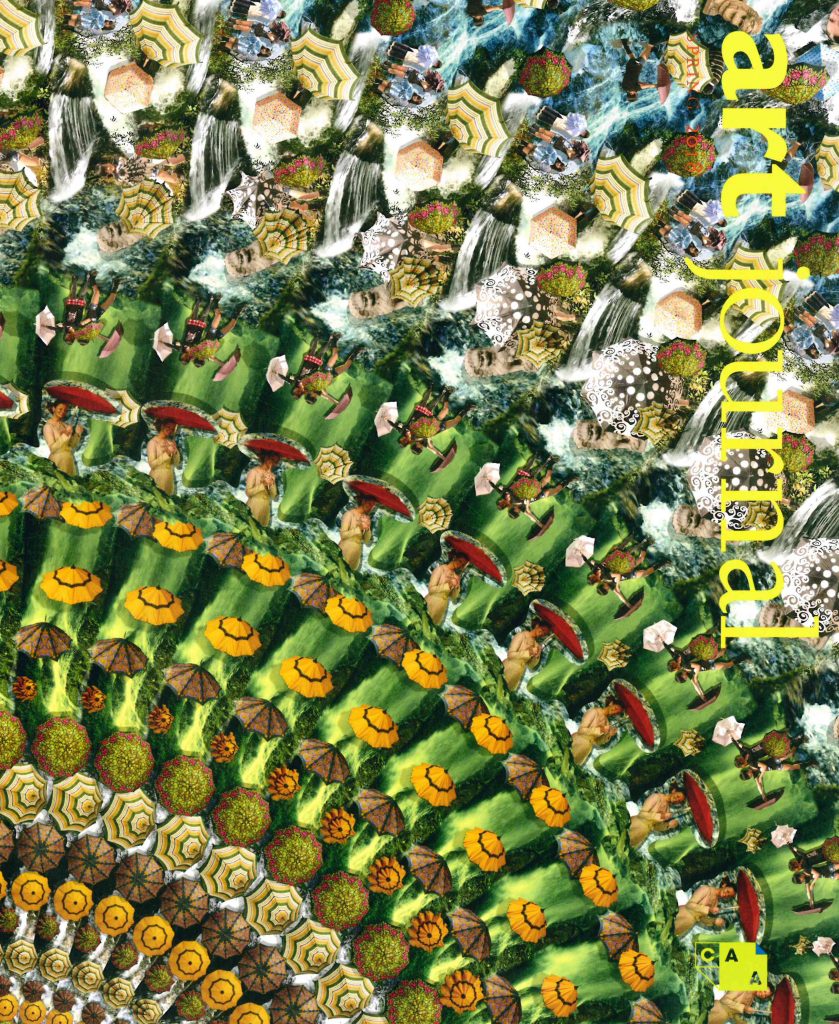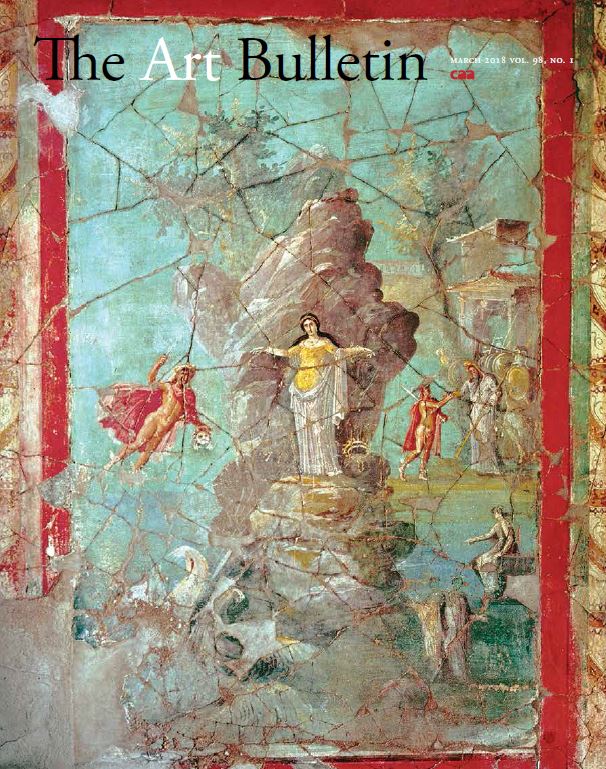CAA News Today
CWA Picks for July 2018
posted by CAA — Jul 05, 2018
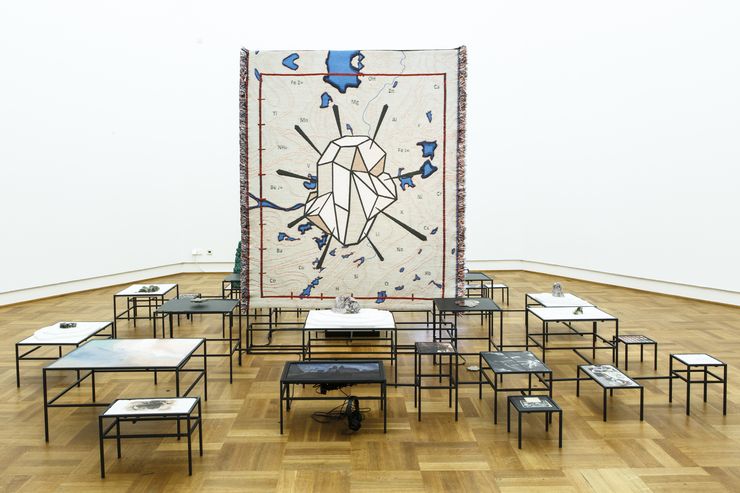
Otobong Nkanga, In Pursuit of Bling, 2014, on view at the Museum of Contemporary Art Chicago through September 2nd. Photo: Eva Broekema
CAA’s Committee on Women in the Arts selects the best in feminist art and scholarship to share with CAA members on a monthly basis. See the picks for July below.
Teresa Burga: Aleatory Structures
May 26—August 18, 2018
Migros Museum für Gegenwartskunst
Limmatstrasse 270
CH-8005 Zurich
Teresa Burga: Aleatory Structures, is the first retrospective in Switzerland of this arguably feminist Peruvian conceptualist –a central figure of the 1960s Peruvian avant-garde– whose recent rediscovery has gained her both international recognition and a second wind after a three-decade hiatus from art making. The exhibition brings together a large number of works that range from early paintings, modular sculptures and Pop environments to the drawings and multimedia, often cybernetic, installations which mark the complexity of her conceptualist practice, as well as its silent unfolding while working as a Customs employee when the dictatorship limited the exhibition possibilities of her vanguard proposals. In effect the show captures not only the diversity of her practice but of the ways in which it records and challenges the social realities and power structures of her changing times in Peru both as an artist and a woman.
Burga’s gendered concerns and depersonalized aesthetics coalesced through Pop experimentation with painting collages, objects and environments in a milieu of anti-modernist rebellion that breached the gap of Limanese art and life with ephemeral art environments and happenings. Indeed she positioned herself as a female Pop artist in 1967, devoting her solo exhibition at Cultura y Libertad Gallery to a critical representation of middle-class womanhood—both a testament as well as a feminist critique of the developmentalist euphoria of 1960s Peru. The situation of women in patriarchal society surfaces at another brief moment of hope in Peru, the return to democracy after General Alvarado’s military regime, through her collaboration with psychotherapist Marie-France Cathelat for the radical research-based work for the Perfil de la Mujer Peruana (Profile of the Peruvian Woman), 1980-1 that surveyed anonymously the living conditions of 129 middle-class women living Lima in their twenties about a wide assortment of issues structured along twelve “profiles” (physiological, psychological, social, educational, cultural, religious, professional, economic, etc). Between these two landmarks, Burga’s representation of women underwent transformations textured by the conceptualist turn of her work before and after her graduate studies at the School of the Art Institute of Chicago (1968-1970), as manifested by her now celebrated multimedia self-representation Autorretrato. Estructura. Informe. 9.6.72. (Self-Portrait, Structure, Report, 9.6.72), 1972 through which Burga combined her critique of subjectivity and systems of representation, making the body matter for a critical exposure and ground for escaping its biopolitical control.
Mona Hatoum: Terra Infirma
April 6—August 11, 2018
Pulitzer Arts Foundation
3716 Washington Boulevard
St. Louis, MO 63108
Originating from the Menil Foundation and bringing more than 30 major works from European and US collection, this is the first large-scale solo exhibition in the US in 20 years of the celebrated London-based Palestinian artist Mona Hatoum.
Merging the languages of Minimalism and Surrealism, through a feminist lens, while having experimented with a variety of media that range from performance to film, Hatoum is istinguished for a potent sculptural and installation vocabulary that–drawing often from everyday domestic objects and engendering conflicting emotions of fear/revulsion and attraction/fascination–critically investigates ideas of home and displacement, while engaging with conditions of timely global instability and political upheaval, as well as timeless human questions.
Nairy Baghramian: Breathing Spell
May 17—October 14, 2018
Reina Sofia, Palacio de Cristal
Paseo República de Cuba,
Madrid, Spain
Large forms remeniscent of prosthetics and cartilagenous body parts lie scattered inside Madrid’s Crystal Palace, a 19th century iron and glass paean to industrialized progress. Made by Nary Baghramian, these sculptures complement the rigid organicism and transparency of their architectural setting. Trussed to columns and hugging the walls, Baghramian’s installation emphasizes contingency—the body supported, and molded by its surrounds. Born in Isfahan, Iran, the artist’s work has, in the past, focused on “the political implications of interior design,” pointing out that both women and gay men were made to culturally demur from the realm of architecture proper in favor of design and the domestic sphere. Semi-transparent tubular structures abound here—some quietly take up residence by the curving walls like banquettes of seating, and others crawl over the top of the Palacio de Cristal’s roof, like skeletal grubs.
Kim Zumpfe: outside the length of a room | or | dividing into the blue sun
May 5—September 9, 2018
Grand Central Art Center
125 N. Broadway
Santa Ana, CA
In the heart of Santa Ana’s arts district, Kim Zumpfe has created a bifurcated space evoking both shelter and disaster site. Upstairs the vision is bleak—a couch, stripped of all its plush, offers the only seating; photographs of discarded fruits are pinned to stacks of plywood, and a video monitor plays a loop of a seemingly bucolic lake view. Below, bedrolls made of fabric featuring rejected objects designed for prisons are spread about—small monitors play a blue, slow-motion video of what appears to be the sun’s surface. A tea kettle and a stash of bottled water serves as a welcome convivial gesture in this tunnel-like space. Recently Zumpfe enacted a performance, reminiscent of the anarchitectural gestures of Gordon Matta-Clark, in which she “drew” a linoleum bisecting the space vertically. Using a yellow crowbar to make her marks in plywood, drywall, plaster, and linoleum—this seemingly simple task proved herculean. The remaining marks from this performance remind us that space can be transformed, but only with great effort.
Penny Siopis: This is a True Story, Six Films (1997-2017)
February 14—July 15, 2018
Zeitz Museum of Contemporary Art Africa
Silo District, S. Arm Road
Cape Town, South Africa
Best known for her “cake” and history paintings of the 1980s and 1990s, over the past twenty years Penny Siopis has also made films. Strung together from many bits of found footage, My Lovely Day, 1997, Obscure White Messenger, 2010 and The Master is Drowning, 2012, emphasize how cultural and political realities (such as apartheid in South Africa), shape personal narratives. Siopis subtitles her videos with the voices of a variety of characters; whether these people are real or imagined, it might not matter much, for each has a complicated relationship with their context. This exhibition, at the newly built Zeitz Museum of Contemporary Art Africa, provides the first opportunity to view the artist’s video output at once.
Otobong Nkanga: To Dig a Hole That Collapses Again
March 31—September 2, 2018
Museum of Contemporary Art
220 E. Chicago Ave.
Chicago, IL
Interrogating how a raw material or natural resource is made into a product, for example soap or makeup, is at the heart of Otobong Nkanga’s artistic efforts. In her work, which is by turns sculptural, performative, olfactory, and wall-based, Nkanga opens out the histories of manufacture and production (and thus the extended legacies of colonialism and imperialism) so that we might determine the human and environmental costs of such processes. The body is the primary metaphor through which invasive incursion and extraction are imagined in this collection of wide-ranging works. In large-scale tapestries like Infinite Yield, 2015, glittery minerals cover the breast, face, and genitals of an androgynous, brown figure, who stands in the midst of a draining funnel. In the center of this exhibition, black soap is stacked in circular constructions—it is manufactured by the Carved to Flow Foundation (which Nkanga founded) in Akwa Ibom, Nigeria. Performers on hand describe the process of the soap’s creation, thereby amplifying the themes running throughout the show. Available for purchase in the exhibition, the circuits of capitalism serve to support the artist’s social practice.
New in caa.reviews
posted by CAA — Jun 29, 2018
Andrea Gyorody reviews Paik’s Virtual Archive: Time, Change, and Materiality in Media Art by Hanna B. Hölling. Read the full review at caa.reviews.
Lisandra Estevez reviews Baroque Seville: Sacred Art in a Century of Crisis by Amanda Wunder. Read the full review at caa.reviews.
Sabine T. Kriebel reviews Photography and Humour by Louis Kaplan. Read the full review at caa.reviews.
News from the Art and Academic Worlds
posted by CAA — Jun 27, 2018
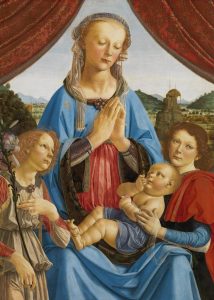
Andrea del Verrocchio and Leonardo da Vinci, The Virgin and Child with Two Angels, c. 1468–70. Courtesy National Gallery, London, via Apollo Magazine.
‘Mounting an Exhibition about Leonardo Da Vinci Is an Act of Hubris’
Chief curator Laurence Kanter reflects on Yale University Art Gallery’s upcoming exhibition. (Apollo Magazine)
The Histories of Ten Colors Through Multiple Lenses
A new book considers color across multiple disciplines, including film and literature. (Hyperallergic)
20 Curators Taking a Cutting-Edge Approach to Art History
Artsy shares their top twenty curators who are working through a 21st-century lens. (Artsy)
How to Spot a Perfect Fake: The World’s Top Art Forgery Detective
Forgeries have got so good that Sotheby’s has brought in its own in-house expert. (The Guardian)
Backpack-Sized Archiving Kit Empowers Community Historians to Record Local Narratives
A new project from the University of North Carolina at Chapel Hill equips community partners with tools to start material and oral history archives. (Hyperallergic)
‘There Is So Much You Go Through Just Trying to Make It’: Amy Sherald on How She Went From Obscurity to a Museum Survey (and the White House)
The 44-year-old artist reflects on her breakout year, and the years of hard work leading up to it. (artnet News)
Call for Responses | Beyond Survival: Public Funding for the Arts and Humanities
posted by CAA — Jun 19, 2018
Art Journal Open seeks 500-word responses for a Forum on Public Funding for the Arts and Humanities, convened by Sarah Kanouse, Jeremy Liu, Catherine Morris, and Mimi Thi Nguyen.
Moderated contributions will be posted to an online forum hosted by Art Journal Open. Some respondents may subsequently be invited to expand their text into a longer article.
Responses will be accepted through August 20, 2018 to: publicfundingforum@gmail.com
Beyond Survival: Public Funding for the Arts and Humanities
Three decades into the long culture wars, how are artists, scholars, and cultural organizations navigating shifting political, community, and financial tides? Where have we encountered friction or congruence between federal priorities and our work at state, local, and community levels? Has our work changed – in structure, presentation, or substance – in response to these priorities?
Despite threats of elimination earlier in the year, federal funding for the arts and humanities has been preserved—at least for now. While rightly celebrating this collective accomplishment, we must also acknowledge that ideological pressures on US cultural policy are performed as much through selective funding as outright defunding. Each successive presidential administration has stamped its particular priorities on funding agencies, shaping arts and humanities research through both direct and indirect means. The grantmaking models now used by the National Endowment for the Arts and National Endowment for the Humanities were carefully devised to avoid the headline-grabbing controversies of the 1980s culture wars while articulating the value of the arts and humanities to a non-elite, often skeptical public. Simultaneously, arts and scholarly communities have sometimes struggled for diversity in terms of race, class, and gender. Nonprofit cultural and educational institutions evolved alongside twentieth-century funding models, with diminishing federal funding giving way to support from private philanthropy, and its concomitant priorities. Surviving funding programs often expect artistic and intellectual activities to contribute to community development, shore up fraying social services, or emphasize their policy implications—a challenging charge made more difficult by the patchwork of fragile social, economic, community, and technological infrastructures on which such work rests.
In an environment of heightened scarcity and competitiveness, how do we negotiate the differing audiences, priorities, and compromises that inevitably register in creative, academic, and public discourse? How do we defend our existing, imperfect, imperiled institutions while also calling for—and ultimately achieving—more expansive public funding of a wider range of aesthetic and political voices?
We seek 500-word responses to these questions from communities of art-making, scholarship, and exhibition practice. Moderated contributions will be posted to an online forum hosted by Art Journal Open. Some respondents may subsequently be invited to expand their text into a longer article. Responses will be accepted through August 20, 2018 to publicfundingforum@gmail.com.
Sarah Kanouse
Artist and Associate Professor
Department of Art + Design
Northeastern University
Jeremy Liu
Senior Fellow for Arts, Culture and Equitable Development
PolicyLink
Catherine Morris
Senior Curator for the Elizabeth A. Sackler Center for Feminist Art
Brooklyn Museum
Mimi Thi Nguyen
Associate Professor
Gender and Women’s Studies and Asian American Studies
University of Illinois, Urbana-Champaign
How to Become an Art Editor: An Interview with Phil Freshman, President of Association of Art Editors
posted by CAA — Jun 12, 2018

Freshman’s home office. All photos courtesy Phil Freshman.
Phil Freshman is a freelance art editor and president of the Association of Art Editors (AAE). Formerly a staff editor at the Los Angeles County Museum of Art (1980–84), the J. Paul Getty Museum (1985–88), the Walker Art Center (1988–94), and the Minnesota Historical Society Press (1995–99), he has worked on numerous books, exhibitions, and other projects, focusing mainly on art history, architecture, photography, and design.
We were curious what advice Phil might have for aspiring art editors. CAA media and content manager Joelle Te Paske spoke with him in April 2018.
Joelle Te Paske: I’m glad we have a chance to talk, especially to learn more about the Association of Art Editors and take a look at what you do.
Phil Freshman: When I talk to people about the AAE who didn’t know about it previously, they’re typically glad to know it exists.
JTP: It’s great. So, what are you working on nowadays?
PF: The last catalogue I edited was for the Minneapolis Institute of Arts, which recently took the “s” off its name and started calling itself “Mia.” Anyway, the book was about contemporary Japanese lacquer sculpture, and was tied to an exhibition that is on view now and will be up until late June. It’s a field of study I had never thought about much. You think of Japanese pottery, right? But you don’t think of pure sculpture. A very interesting and challenging project.
Right now, I’m editing a memoir by a lifelong friend who recently retired from the law. He spent a year hoofing it around West and East Africa in the early 1970s and thought he would get around to writing a memoir right afterward. Then 45 years went by like the wave of a hand, and here he is, doing it now. So, it’s a pleasure to help him, to know enough to make his manuscript better.
JTP: You’re learning a lot about him, I bet.
PF: I am. And that was a part of his life I hadn’t known much about to begin with.
JTP: How did you become an editor?
PF: I was a Los Angeles lad who first wanted to be a newspaper reporter. But despite trying for several years, it didn’t work out. I then lived for three uninterrupted years in Israel, Iran, East and West Africa, and Spain, finding ESL teaching jobs along the way. I came back home to get an ESL degree at UCLA. During that time, a friend in LA whose firm published books dealing with Western US history hired me part-time to review slush pile manuscripts and proofread book galleys.
A couple of years later, with just that little bit of experience but intrigued by the work, I applied for a copyeditor-proofreader job at the Los Angeles County Museum of Art. I took the required test (along with something like 200 other applicants), was interviewed, and then hired. I thought, “Oh, God. Now I actually have to do something.”
JTP: Yes, now it was real!

Ralph Rapson: Sixty Years of Modern Design (1999). Freshman edited this and the other books illustrated here.
PF: At first, I had no idea what I was doing. But my senior editor was a great teacher. When he left the museum—too soon, alas—I was the only editor there. I worked on books about American painting and printmaking, 18th-century fashion, contemporary art, and more, plus the monthly members’ magazine, annual reports, lots of brochures, flyers, exhibition labels. It was full immersion and very long weeks until, after six months, I was allowed to hire somebody. Eventually, I had three editors.
JTP: That makes sense. Rather than just one, working at that scale.
PF: Right. But when I was hired from the Getty Museum to be the Walker Art Center’s first-ever editor, in 1988, I was once again a solo act—and remained one for three years. The Walker had an ambitious program of publishing catalogues and presenting exhibitions on the history of graphic design, Russian Constructivist art, contemporary sculpture, and this, and that, and the other thing! All that plus editing for the Walker’s very active film, performing arts, and PR departments. I worked 70 to 80 hours a week, and that didn’t stop even after I was finally able to hire an assistant editor.
JTP: There was no getting around the fact that you had to go through all that material.
PF: Right. Not just going through it all but also needing to be attuned to a constellation of details. That was, as it so often is, the job—the details, as well as panning out for the whole picture. And more often than not, I didn’t receive all the materials I needed at the get-go. Unfortunately, that’s all too typical in this racket. In fact, sometimes you get a little bit, and then some more dribbles in, then a bit more, and you have to assemble the material as it’s unfolding before you, make everything hang together. I had to develop a host of skills over the years, including diplomacy—at which I’ve never been adept.
Beyond all that, one reason I was initially attracted to editing was that I had no patience for formal schooling. I’ve found that editing has provided a rich, ongoing education in which I get a front-row seat to subjects about which I might otherwise never have learned a thing. Not to mention exposure to fascinating people, and to situations I wouldn’t have encountered if I weren’t doing this work. There are certainly things to hate about it, but the balance sheet works out in its favor.
JTP: It’s so detail-oriented, but you are committing your time to new projects and scholarship. It’s integral to the work.

Dining with the Washingtons: Historic Recipes, Entertaining, and Hospitality from Mount Vernon (2011).
PF: Yes. And I also keep coming back to this: you have to keep asking questions. One instinct that made me want to be a reporter applies perfectly to editing. I ask questions, and then ask more, and then ask some more. Often enough, I’ve had authors and curators who are responsive to that. The relationship works best when they understand that I’m on their side, trying cover any holes that open up because they were writing too fast. But some of them are resentful, insecure, brittle, and they can make that sort of thing difficult.
JTP: Yes, I can see it going both ways. I would think, though, that writers with more experience realize having a good editor can be like a good friend, someone who can make your work better before it goes out into the world.
PF: That’s it. I’ve worked with a few pretty well-known authors with whom it felt like a collaboration. They liked the back-and-forth. They didn’t just take all of my suggestions but said, “No, let’s discuss this further.” And then you get to a middle way that’s better than what you thought of, or than what they thought of.
JTP: Would you recommend that editors who are just starting out keep that in mind?
PF: Definitely. Another thing I like to tell aspiring editors is, “Go to the library.” You know, the library?
JTP: I’ve heard of those.
PF: [Laughs] Get hold of exhibition catalogues and other art books on a range of subjects, and then review all the separate essays or chapters, the footnotes and bibliographies, the plates, figure references, checklists, and the rest. And bear in mind, as you’re reading, that it’s highly unlikely that the original manuscript was delivered intact to the editor at beginning of the process. Probably dribbled in over a period of weeks, if not months.
You have to take the bits and pieces and make them fully consistent, factually accurate, grammatically correct, and maybe even interesting! So, I don’t know that someone has to have an art background per se in order to be an art editor. But I would say that having a feel for and a knowledge of language, a willingness to become genuinely invested in a subject, a good visual memory, and an insane attention to detail are all necessary.
JTP: I imagine AAE would be a great resource for people starting out. Where else should they look?
PF: LinkedIn is a good source. The old cold-call approach is not bad. Find people who work where you might want to work and contact them. I recently spoke with an editor friend who, though she had just quit Facebook, found a valuable online organization on it called Editors’ Association of Earth. She described it as a private, heavily moderated group and a place where you can engage with other editors, ask questions freely, and get advice.
JTP: Editors likely want to share their skills—many have devoted their careers to sharing knowledge, after all—and it seems like that would be good for people starting out.
PF: I’d also suggest getting immersed in The Chicago Manual of Style. And finding books about editing. Here are some I recommend:
- The Subversive Copy Editor, by Carol Fisher Saller. University of Chicago Press, 2009. Her monthly online Q & A, via the U of Chicago Press Website is terrific. Need to sign up for it.
- Exhibit Labels: An Interpretive Approach, by Beverly Serrell. Rowman and Littlefield, 2015 (second edition).
- Line by Line: How to Improve Your Own Writing, by Claire Kehrwald Cook. Houghton Mifflin, 1985. (This is the one I have, but there are probably subsequent editions.)
- On Writing Well, by William Zinsser. Collins, 2006 (30th anniversary edition).
- The Copyeditor’s Handbook: A Guide for Book Publishing and Corporate Communications, by Amy Einsohn. University of California Press, 2006 (second edition). A very good primer on the basics. It also includes copyediting exercises and answer keys.
JTP: That’s terrific. Thank you.

Toward a Simpler Way of Life: The Arts and Crafts Architects of California (1997).
PF: I’d also suggest that if a nearby college offers copyediting classes, take one. It can be very useful to learn the mechanics in a formal way. Such classes also help you see whether or not you have an appetite and instinct for editing.
JTP: This is important, too, because it’s an intensive practice.
PF: Right. Once you get involved in a job, it’s immersive. It is the writer’s book, the museum’s book, the publisher’s book, but you can’t ever say to yourself, “Well, it’s on them. I wash my hands of this,” or, “It’s not going to have my name on it.” You have to feel responsible for whatever project you’re on. In other words, you can’t say, “It’s just a job.”
Another thing to consider: Back in the days when I had stars in my eyes, I’d think, “How wonderful it would be to work for XXX Museum of Art. So prestigious.” But in fact, some of my best experiences have been with smaller institutions and some of my worst with larger, “important” ones.
JTP: That’s good to know.
PF: Usually, there are good people in such places. Sometimes a good attitude. Less bureaucracy. And often you can get things done more fluidly.
Another thing important to me is having solid relationships with graphic designers. I’ve worked with good ones and very bad ones. By good, I mean ones who like to share suggestions about what might work, ones who welcome it when you point out why a certain typeface, or size of type, or caption location in relation to pictures might be reconsidered. It’s a conversation. And then on the other hand, there’s the head-banging-against-the-wall experience of having to deal with the other kind of graphic designer. One of them referred to text as “texture,” something mostly useful as a visual complement to their brilliant layouts!
JTP: As an editor, I can only imagine [laughs]. Do you ever work in tandem with a graphic designer, presenting yourselves to a client as a team?
PF: Yes. Several designers I know will get a job and say to the client, “I know a good editor in Minneapolis. I’d like you to hire him.” By the same token, I’ll get a job and ask, “Do you have a designer for this?” If the client says no, I’ll offer contact information for three or four designers, making my top preference clear.
JTP: Good to know. Keeping track of the designers you like working with would help you establish a mutual-support system.
PF: That’s right. It helps you feel more comfortable going into a project—you know that you can kid around with the graphic designer, and that you can bitch about the client without worrying it’s going to get back to them.
JTP: Can you name a highlight of being president of AAE? Also, how long have you been president?
PF: I’m president for life [laughs].

The General in the Garden: George Washington’s Landscape at Mount Vernon (2015).
JTP: [Laughs] Like a Supreme Court justice.
PF: You got it. I’ve occasionally had thoughts of not doing it anymore, but it’s not [too taxing]. Well, creating the first version of our soup-to-nuts style guide, in 2005 and 2006, which I did in tandem with three other editors whom I greatly respect—that did take months. But the result was just wonderful. I’m really proud of having done that. And I get lots of good feedback. Also, I like helping editors find work through the job opportunities page.
There’s also a section [on the AAE site] called Helpful Links. It has many sources you might want to refer to as you’re doing research for a book or an exhibition you’re editing.
The site is an open-source one. Anyone can use it freely. One AAE offering not visible on the site, however, is the rates survey we conduct every five years. It includes questions such as “How much do you charge for editing, proofreading, and other separate tasks?” And “Do you charge extra for working on weekends?” Among numerous others. We sort the answers, and provide a report with graphed percentages and selected verbatim responses.
JTP: That’s terrific. Sounds like it would help editors advocate for themselves.
PF: That’s the idea, of course. I don’t post rates-survey reports on the website because I don’t want potential clients, such as curators, browsing them and thinking, “Wow! Looks like I can get away with paying somebody $20 an hour!” But I’m happy to send the reports out to anybody who requests one.
This interview has been edited for length and clarity.
News from the Art and Academic Worlds
posted by CAA — Jun 06, 2018
Irving Sandler, Art Historian Who Was Close to Artists, Dies at 92
Art critic, historian, and longtime CAA member Irving Sandler passed away on June 2nd. (New York Times)
Museum of Modern Art Staff Protest Outside Fundraising Gala, Demanding a Fair Contract
MoMA workers and their supporters rallied outside the Museum to draw attention to ongoing contract negotiations that are currently at an impasse. (Hyperallergic)
Director Okwui Enwezor to Step Down from Munich’s Haus Der Kunst
The renowned curator and art historian announced he is resigning from his post due to health reasons. (Artforum)
Art Sold Separately: Why Are People Buying Free Felix Gonzalez-Torres Posters?
Gonzalez-Torres made his first work that includes a stack of paper in 1988, and his first to consist of a stack constantly replenished with “endless copies” in 1989. (Greg.org)
The Paintings that Turned Persian Art on its Head in the 19th Century
While Persian arts are usually associated in the popular imagination with miniature paintings and carpets, the arts of the Qajar period are characterized by large-scale works and new technologies. (Apollo Magazine)
Elliott Arkin’s Quest to Counter Art World Elitism Culminated in a 10-Foot-Tall Picasso
Artist Elliott Arkin just spent roughly $120,000 of his own money producing a 10-foot-tall sculpture of Pablo Picasso pushing a lawn mower. (Artsy)
Affiliated Society News for May 2018
posted by CAA — May 22, 2018
Affiliated Society News shares the new and exciting things CAA’s affiliated organizations are working on including activities, awards, publications, conferences, and exhibitions. For more information on Affiliated Societies, click here.
International Sculpture Center (ISC)
ISC is offering new graduates the professional resources they need to launch their careers – Student/Young professional membership – at discounted rate of $45. For more info, visit https://www.sculpture.org/documents/aboutisc/specialoffers.shtml
ISC is now accepting applications for our Fall/Winter residency @ Mana Contemporary. Apply today https://www.sculpture.org/residency/mana-update.shtml
Registration opens in June for the 28th ISC Conference: Defining Moments in the Face of Change and is available to ISC members, non-members, students, and all those with an interest in sculpture. Come join us in Philadelphia for engaging panel discussions, networking events, and exciting tours & optional activities. https://sculpture.org/philly2018/
Association of Art Museum Curators (AAMC)
The Association of Art Museum Curators and AAMC Foundation is honored to present a series of three webinars on research, advances, and issues surrounding the topic of provenance. With the establishment of substantial research databases and resources, great progress has been made in researching artworks that may have been subject to unlawful appropriation during the World War II era. As museums work to make their collections accessible online, there is both the need and potential to extend these advances to other categories of objects. The first webinar will acknowledge the impact of the pioneering work in WWII era research and provide updates on the current status within the field. The second session will offer a review of work currently being undertaken for non-WWII era looting and specifically looking at fields, including but not limited to, African Art, Asian Art and Antiquities. In the final session, we will emphasize the interest and need for progress in collaboration across diverse fields, present information on sharing data, and digitization and resources in communicating knowledge. The three webinars will build from seminar to seminar, but do not require attendance at each one to gain value from an individual session. Scheduled over three Tuesdays this June 2018, registration is available at a purchase of a single session or package of all three. Members and non-members alike can register directly online, with group rate packages available to participate. Access to webinar recordings will also be available for viewing with purchase. The first webinar on June 12 is Advances in WWII Era Research; the second on June 19 is Going Beyond WWII Era Research; and the third on June 26 is Sharing Research, Asking New Questions. Register to participate today.
Association of Print Scholars (APS)
The Association of Print Scholars hosted its third annual Distinguished Lecture at the CUNY Graduate Center on January 26, 2018. The curator Rémi Mathis, of the Bibliotheque Nationale de France, delivered the lecture titled “A Means to an End: The Process of Understanding French Prints.”
During the CAA conference in Los Angeles, many members joined us for our affiliated society panel, “Now you see it, now you don’t: Materialism and Ephemeral Prints,” chaired by Dr. Yasmin Railton of Sotheby’s Institute of Art. We also hosted a member’s reception at the East Los Angeles based workshop Self Help Graphics and toured their exhibition on Día de los Muertos.
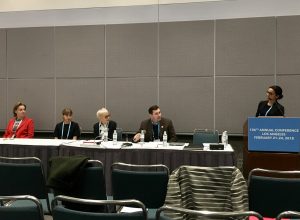
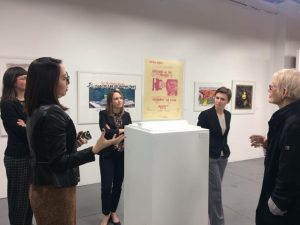
APS is pleased to announce our 2019 CAA panel “Printing Color: Reproducing Race Through Material, Process, and Language,” chaired by Christina Michelon. Michelon is a Luce /ACLS Fellow in American Art and a PhD Candidate in Art History at the University of Minnesota-Twin Cities where she is completing her dissertation “Interior Impressions: Printed Material in the Nineteenth-Century American Home.” Her work has been supported by the Smithsonian Institution, the Winterthur Museum & Library, the Center for Craft, Creativity, and Design, the American Antiquarian Society, and the Chipstone Foundation. “Printing Color: Reproducing Race Through Material, Process, and Language” seeks to investigate the racialized dimensions of print and printmaking. The medium has played a central role in the ideological founding of “race” and its hierarchies through visual representation. However, print’s materials, processes, and the language we use to describe them interface with conceptions of race in ways that require further study. Please be on the lookout for our upcoming CFP.
Society of Historians of Eastern European, Eurasian, and Russian Art and Architecture (SHERA)
The Board of the Society of Historians of Eastern European, Eurasian, and Russian Art and Architecture (SHERA) is pleased to announce the SHERA-sponsored panel for the 50th Annual ASEEES Convention in Boston, MA, December 2018. Dr. Hanna Chuchvaha’s panel “The Passion for Collecting: Collectors and Their Collections in Imperial Russia, 1800-1917” will include papers on Zinaida Volkonskaia’s Allée de Souvenirs (Laura Schlosberg), Print Collections of Female Crafts in Late Imperial Russia (Hanna Chuchvaha), Reform and Rehang in the Tretyakov Gallery, 1913-1917 (Isabel Stokholm) and will be of interest not only to art historians but also to scholars of museology, women’s studies, and visual culture.
Association for Modern and Contemporary Art of the Arab World, Iran, and Turkey (AMCA)
Book Launch Events: “Modern Art in the Arab World: Primary Documents” (April 28 Beirut and May 23 New York)
AMCA is pleased to announce launch events in Beirut (Sursock Museum) on April 28 and in New York (MoMA) on May 23 to celebrate the publication of Modern Art in the Arab World: Primary Documents (2018), edited by Anneka Lenssen, Sarah Rogers, and Nada Shabout. Both events bring to life Modern Art in the Arab World: Primary Documents and the book’s diverse content, multiple collaborators, and rich source materials that aim to further the study of modernism in a global frame.
This anthology offers an unprecedented resource for the study of modernism: a compendium of critical art writings by 20th-century Arab intellectuals and artists. The selection of texts—many of which appear for the first time in English—includes manifestos, essays, transcripts of roundtable discussions, diary entries, exhibition guest-book comments, and letters. Traversing empires and nation-states, diasporas and speculative cultural and political federations, the documents bring to light the formation of a global modernism that includes debates on originality, public space, spiritualism and art, postcolonial exhibition politics, and Arab nationalism. The sourcebook is framed chronologically, and features contextualizing commentaries and essays to assist readers in navigating its broad geographic and historical scope. A newly commissioned essay by Ussama Makdisi provides a historical overview of the region’s intertwined political and cultural developments during the 20th century.
Speakers included:
Zeina Arida, director of the Nicolas Ibrahim Sursock Museum in Beirut
Iftikhar Dadi, associate professor in the Department of The History of Art and Visual Studies at Cornell University
Anneka Lenssen, assistant professor of Global Modern Art in the History of Art Department at the University of California, Berkeley.
Glenn D. Lowry, director of The Museum of Modern Art in New York.
Sarah Rogers, independent scholar.
Nada Shabout, professor of art history in the College of Visual Arts and Design and the coordinator of the
Contemporary Arab and Muslim Cultural Studies Initiative at the University of North Texas.
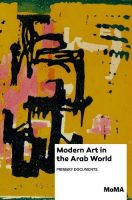
Explore source documents for Modern Art in the Arab World
AMCA has made a number of primary documents in Arabic and French available online. Click here to explore.
The Feminist Art Project (TFAP)
Call For Papers
The Feminist Art Project’s Day of Panels will be co chaired by Christen Clifford and Jasmine Wahi. The Day of Panels will be held at the Hilton in NYC at CAA on Feb 16th, 2019. The 2019 symposium will focus on rape and representation. The co-chairs are looking for papers, video and art that dwell in the sexual wounds of rape and sexual assault and look for the light of sexual justice. We seek a wide array of proposals on possible topics such as rape and representation, the meanings of sexual justice, gender and power in the art world, intersectional feminisms and responses to assault.
How has sexual assault affected feminist art practices? Who has power and why? What institutional changes need to happen to work towards sexual justice? Feminist art has long dealt with the oppressions and violations of colonialism, slavery, and couverture. TFAP 2019 is dedicated to the exploration of sex, power and justice through intersectional art and activism, academics and healing, and creating a shared space: bringing intellect and emotion together to demand bodily autonomy.
The day of panels will feature panels, video art, and a digital gallery.
Paper, panel and performance proposals should include a short (100 word) abstract /description of work, 100 word bio, and any relevant links. Header should read: TFAP 2019 Paper
Video and Image submissions should include links (and passwords, if appropriate) and up to 5 images. Please use email headers: TFAP 2019 Video or TFAP 2019 Image. All images should be labeled: LASTNAME_FIRSTNAME_TFAP.jpg
Please send proposals to
By June 14th.
Association of Academic Museums & Galleries (AAMG)
By popular demand, we’ve expanded the registration capacity for the AAMG Bootcamp Workshop. To add the workshop to your existing conference registration, please email membership@aamg-us.org
What: AAMG Bootcamp for Academic Museums
Where: Lowe Art Museum, University of Miami
When: Thursday, June 21, 9am – 3pm
with Jill Hartz and Barbara Rothermel Lowe Art Museum, University of Miami
Only open to AAMG and UMAC members; $100 (lunch and materials included)
This intensive professional development workshop covers key concepts and practices in academic museum management. Whether you’re a seasoned professional or new to the field, the workshop offers opportunities to learn about innovative and best practices and share challenges and achievements. We’ll cover mission and governance, advisory boards, strategic planning, our teaching role, working with faculty and students, community relations, and collections management and planning.
Instructors: Jill Hartz, Executive Director, Jordan Schnitzer Museum of Art, University of Oregon / President Emeritus, AAMG Barbara Rothermel, Director, Daura Gallery, Lynchburg College / Vice-Chair, UMAC
Association of Historians of American Art
Panorama: Journal of the Association of Historians of American Art has received an $8,500 grant from the Wyeth Foundation for American Art. A peer-reviewed, open-access online journal dedicated to American art and visual culture in all media, from the colonial period to the present day, Panorama welcomes submissions in various formats, including feature length articles (7,000-10,000 words), research notes (maximum of 2,500 words), book and exhibition reviews, and “Bully Pulpit” suggestions—texts that trace a conversation or debate on a topic that is of general interest to the field.
New Media Caucus (NMC)
The New Media Caucus (NMC) is pleased to announce the inaugural Advisory Board. Voted in by the Board of Directors, the members of the Advisory Board will assist with the core missions and the growth of the caucus. We welcome Hasan Elahi, internationally recognized media artist and Associate Professor of the University of Maryland; Sue Gollifer, pioneer of early computer art, Director of ISEA International and academic staff at the University of Brighton in the UK; and Guna Nadarajan, theorist, curator, and Dean and Professor at the Penny W. Stamps School of Art and Design at the University of Michigan. We look forward to working with, and learning from, our esteemed colleagues.
Society of Architectural Historians (SAH)
The Society of Architectural Historians has received a three-year, $120,000 grant from The Richard H. Driehaus Foundation for general operating support. The grant provides SAH with vital unrestricted income needed to fulfill its educational mission and support day-to-day operations.
The Society of Architectural Historians announced the 2018 recipients of the SAH Publication Awards and the SAH Award for Film and Video at its 71st Annual International Conference awards ceremony on April 20, at the Landmark Center in Saint Paul, Minnesota. The SAH Publication Awards honor excellence in architectural history, urban history, landscape history and historic preservation scholarship as well as architectural exhibition catalogues. The SAH Award for Film and Video is an annual award that was established in 2013 to recognize the most distinguished work of film or video on the history of the built environment. SAH will begin accepting nominations for the 2019 awards on June 1, 2018.
SAH is accepting applications for the 2018 SAH/Mellon Author Awards, designed to provide financial relief to scholars who are publishing their first monograph on the history of the built environment. The application deadline is May 31, 2018.
SAH is accepting abstracts for its 72nd Annual International Conference in Providence, Rhode Island, April 24–28. The submission deadline is 11:59 pm CDT on June 5, 2018. View the full call for papers at sah.org/2019.
International Association of Art Critics United States (AICA-USA)
AICA-USA‘s 2018 annual meeting was Saturday, May 19 at The Brooklyn Rail Headquarters at Industry City in Sunset Park, Brooklyn. The meeting coincided with a panel discussion featuring David Salle and Carroll Dunham.
AICA-USA board member Phong Bui says: “Ever since Susan Harris was the guest critic for the Rail’s November 2016 issue, which featured a luminous selection of our writer colleagues who are AICA members and board members, we have kept the collaboration alive with many AICA writers contributing regularly to our Art Seen reviews, such as Barbara and Alfred MacAdam, Lilly Wei, Eleanor Heartney, Amei Wallach, and Susan herself as an ongoing effort to keep the collaboration alive.
On the occasion of our forthcoming event featuring David Salle and Carroll Dunham on their respective publications, How to See and The Collected Writings of Carroll Dunham, I thought it would be a timely occasion to create a panel discussion coinciding with Industry City’s Open Studios, which invites the local artist community to participate.”
David Salle in Conversation with Carroll Dunham, moderated by Phong Bui
Panelists: Josephine Halvorson, Adam Pendleton, Martha Schwendener, and Amei Wallach
Rail HQ
253 36th Street, Suite C304
Industry City in Sunset Park
Saturday, May 19
Coffee and bagels: 10:30am
Conversation: 11am–12:30pm
AICA-USA Business Meeting: 12:30–1:00pm

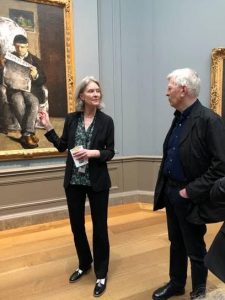

On May 8 and 9, 2018, AICA-USA members gathered in Washington D.C. for a two-day visit. 2017 AICA-USA Distinguished Critic Lecturer Paul Chaat Smith led members through his much-lauded exhibition, Americans, at the National Museum of the American Indian in Washington DC. AICA-USA member John Elderfield and his colleague Mary Morton led members through the exhibition Cézanne Portraits, which they co-curated at the National Gallery of Art.
The group also toured Lynn Cooke’s exhibition Outliers and American Vanguard Art at the National Gallery. AICA-USA was fortunate to have been granted ten VIP passes for entry to the National Museum of African American History and Culture, which members enjoyed without having to undergo the typical long wait time for entry passes.
Association for Textual Scholarship in Art History (ATSAH)
Recent member’s publications
Charles Burroughs, “Botticelli’s Stone: Giorgio Vasari, Telling Stories, and the Power of Matter.” Artibus et Historiae 76 (2017): 297–325.
Liana De Girolami Cheney, “Giorgio Vasari’s planetary ceiling: A Neoplatonic Voyage.” In Artistic Responses to Travel in the Western Tradition, ed. Sarah J. Lippert (London: Routledge Research in Art History, 2018): 158-169.
Karen Hope Goodchild, “Masaccio, Andrea del Sarto, Il Lasca, and the Sausage School of Florence.” Source. Volume 36, number 3/4 (Spring/Summer 2017): 178-187.
Sarah J. Lippert, ed. Artistic Responses to Travel in the Western Tradition
(London: Routledge Research in Art History, 2018).
ANNOUNCEMENT AWARDS for Students and Scholar
ASSOCIATION FOR TEXTUAL SCHOLARSHIP IN ART HISTORY
In commemoration of our 30th anniversary, ATSAH plans to offer two awards: one prize for the best article by an emerging scholar (no higher than Associate level). The topic may range from classical to Pre-Raphaelite art, reflecting the aims of ATSAH. The second is a small travel grant for junior scholar presenting a paper an ATSAH session. The board of ATSAH selects these awards.
For further data, contact:
Liana Cheney, PhD, President of ATSAH,
lianacheney@earthlink.net
SECAC
Lawrence Jenkens, 1st Vice-President and ex-officio chair of the SECAC Nominating Committee is pleased to announce the election of the following members to the SECAC Board of Directors for a three-year term of appointment that begins immediately: For Alabama, Wendy DesChene, Professor of Art, Auburn University; for Kentucky, Eileen Yanoviak, Director of the Carnegie Center for Art and History, New Albany, Indiana; for Louisiana: Jill R. Chancey, Assistant Professor of Art History, Nicholls State University, Thibodaux, Louisiana; for North Carolina: Kathryn Shields, Associate Academic Dean, Guilford College, Greensboro, North Carolina; and for the Third At-large Seat: Claire L. Kovacs, Director, Augustana Teaching Museum of Art, Augustana College, Rock Island, Illinois.
Community College Professors of Art and Art History (CCPAAH)
The Community College Professors of Art and Art History will have two opportunities to submit presentations for our panels next year. Please watch the news from CAA to submit a proposal for our session at next year’s conference in New York. We will also have an opportunity to submit for our panel at the FATE (Foundations in Art Theory and Education) Conference in Cincinnati next spring. Watch both of their websites for more information and the details for submissions. For more information contact Susan Altman, ccpaah@gmail.com
Foundations in Art: Theory and Education (FATE)
http://www.foundations-art.org/
FATE’s 17th Biennial Conference will be hosted by Columbus College of Art & Design in Columbus, Ohio on April 4th-6th, 2019. The call for sessions closed on May 18, but conference organizers will soon be seeking paper proposals for panel discussions and workshop events surrounding the conference theme, Foundations in Flux. http://www.foundations-art.org/conferences
Positive Space is FATE’s bi-monthly podcast providing opportunities for those passionate about art foundations to discuss and promote excellence in the development and teaching of college level foundations in art & design studio and history classes.
In Episode 30, of FATE’s Positive Space podcast we discuss creative detours, the mystery of art, becoming comfortable in your own skin, and the habit/repetition, and courage it takes to make things, with artist & educator, Gary Setzer, Associate Professor, Division Chair of the First Year Experience at the University of Arizona.
Episode 29 is a discussion about experimentation. Everyone talks about it, but practical examples of how to implement experimentation within our creative studios/classroom spaces are rarely deeply examined. Lily Kuonen, Associate Professor & Foundations Coordinator at Jacksonville University, discusses her artwork which she describes as PLAYNTINGS (play + paintings) and how the element of playful experimentation has become a crucial aspect of her teaching pedagogy.
Episode 28 was recorded live at the FATE panel at the 106th Annual College Art Association Conference held in Los Angeles, moderated by Naomi Falk, the FATE CAA Representative.
If you have podcast ideas, contact us!
Positive Space has a phone number: 904-990-FATE. Give us a call & record a message today or visit: http://www.foundations-art.org/positive-space-podcast
Membership: Starting the 2018/2019 membership period, FATE has made changes to the Individual Membership fees including a new Adjunct Faculty Membership rate for part-time and contingent faculty members: http://www.foundations-art.org/membership
The Avant-Garde and the Global South, Artworks in Motion, and More in Art Journal
posted by CAA — May 15, 2018
“Proposition Avant-Garde: A View from the South,” by Geeta Kapur, the distinguished art critic, challenges readers of Art Journal to reconsider, reclaim, and rethink the idea of the avant-garde. The text by the Delhi–based Kapur appears for the first time in the Spring 2018 issue of the journal, along with responses from the scholars Saloni Mathur and Rachel Weiss.
Also featured in the recently published issue are two projects by artists whose works provide illusions of motion. For The Virtual Immigrant, Annu Palakunnathu Matthew created a flip-motion lenticular card, inserted in each copy of the journal, which reveals two interlaced portraits of a young call center worker in India, one image in the casual Western address she wears at work, where she speaks in an acquired American accent, the other in the traditional Indian clothing she wears on more formal occasions. Matthew’s project features multiple portraits of three other call center workers; by calling a toll-free number (844-984-7882) on the back of the card, readers can hear short recordings in which the workers speak about the two cultures they inhabit in the course of their lives.
In his project Material Motion, Eric Dyer exhibits works from the last dozen years based on the zoetrope, a form of animation devised in the nineteenth century. Stills featured on the cover and interior pages of the journal show the evolution of the idea in the artist’s hands, first in spinning sculptures that reveal dozens of tiny animated details—cyclists zooming through an urban landscape; umbrellas furling, unfurling, and passing through rows of people and other umbrellas. Dyer further extended the zoetrope principle in numerous other animated pieces, including two DIY pieces that Art Journal readers can complete with a record turntable and a smartphone app.
The issue features three long-form scholarly essays: the curator Luigia Lonardelli on the unfolding of the 1973 Contemporanea, a massive multidisciplinary exhibition staged in an underground parking lot in Rome; Nika Elder on the repeated appearance of a seemingly simple shift dress in the 1980s–90s photographs of Lorna Simpson, a garment closely examined here for the first time; and Steven Jacobs on a 1960 film by Luc de Heusch in which René Magritte extended his artistic project through cinematic means, gnomically restaging some of his best-known paintings in his home.
The Reviews section opens with Joe Madura’s assessment of the exhibition and catalogue for Art, AIDS, America, with a special focus on the final iteration of the traveling show in Chicago. The section continues with reviews of Amy Bryzgel’s Performance Art in Eastern Europe (reviewed by Adair Rounthwaite), Jenni Sorkin’s Live Form: Women, Ceramics, and Community (by Glenn Adamson), and Jane McFadden’s Walter De Maria: Meaningless Work (by Amanda Boetzkes).
CAA sends print copies of Art Journal to all institutional members and to those individuals who choose to receive the journal as a benefit of membership. The digital version at Taylor & Francis Online is currently available to all CAA individual members regardless of their print subscription choice.
Want to see more? Join CAA today and explore the Spring issue in full.
Explore the Latest Issue of The Art Bulletin
posted by CAA — May 01, 2018
A spectacular fresco from early first-century Pompeii is featured on the cover of the March 2018 issue of The Art Bulletin. Drawing on a palette of aqua, yellow, and deep red, it depicts Perseus rescuing Andromeda from captivity on a rocky promontory. The fresco appears in Nathaniel B. Jones’s essay “Starting from Places: Continuous Narration and Discontinuous Perspectives in Roman Art,” which explores how the painters of the time represented multiple temporal moments in a single visual field.
Two essays also featured in the issue examine diverse medieval pilgrimage practices: Conrad Rudolph considers the visual tour guides used at European sites, notably Canterbury, and how they enhanced the social and public reception of works of art; Talia J. Andrei investigates the pilgrimage mandala paintings of Japan’s Ise shrines and the ways they allude to the power and authority of individual Buddhist temples. In the sixteenth-century miniature paintings that depict the ceremonial presentation of gifts from Safavid shahs to Ottoman sultans, Sinem A. Casale locates an unusual opportunity to assess the agency of gifts through their visual representation rather than their materiality. John Ott finds that Hale Woodruff’s six-panel mural of the early 1950s, The Art of the Negro, presents an inclusive, nonlinear visual history of global art that also destabilizes conventional narratives of the origins of modernism. The role of photography during the 1980s human-rights conflicts between the United States and Nicaragua is the subject of an essay by Erina Duganne, who focuses on postmodernist critique of photography as revealed in a 1984 exhibition intended to counter misrepresentations in the news media.
The reviews section, on the theme “Transatlantic,” features recent books on images and objects from the New World in Medici Florence, cross-cultural encounters in sixteenth-century Peru, a queer reading of the formation of the modernist canon, and contemporary black diaspora art around the Atlantic.
CAA sends print copies of The Art Bulletin to all institutional and individual members who choose it as a benefit of membership. The digital version at Taylor & Francis Online is available to all CAA individual members regardless of their print subscription choice.
Want to see more? Join CAA today and explore the March issue in full.
Zachary Kaiser presents CitationBomb on Art Journal Open
posted by CAA — Apr 24, 2018
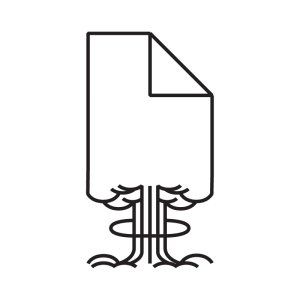 In a new project for Art Journal Open, Zachary Kaiser presents CitationBomb, an app that aims to overflow the Google Scholar algorithm and subvert the systems of metrification that track academic impact, influence, and success.
In a new project for Art Journal Open, Zachary Kaiser presents CitationBomb, an app that aims to overflow the Google Scholar algorithm and subvert the systems of metrification that track academic impact, influence, and success.
Pointing to the difficulty, if not impossibility, of opting out of systems that track output and activity, Kaiser presents CitationBomb as one tactic through which academics may push back against algorithmic structures.
Kaiser’s new piece, “Citation Bombing: Tactical and Symbolic Subversion of Academic Metrification,” featuring an introduction by Art Journal Editor-in-Chief Rebecca Brown and a scholarly essay by Kaiser, is up now on Art Journal Open.
Art Journal Open is a forum for the visual arts that presents artists’ projects, conversations and interviews, scholarly essays, and other forms of content from across the cultural field. Published by CAA, Art Journal Open is the online, open-access affiliate to Art Journal, a quarterly journal devoted to twentieth- and twenty-first-century art and art history.



